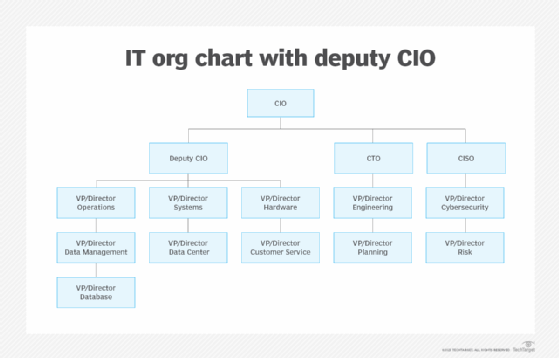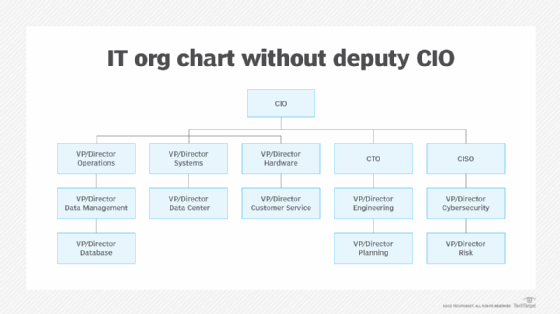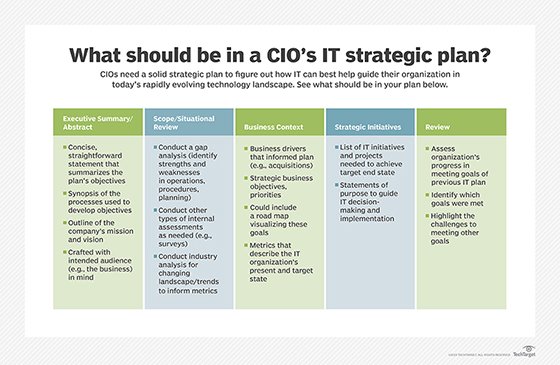deputy CIO (deputy chief information officer)
What is a deputy CIO (deputy chief information officer)?
Deputy CIO (chief information officer) is a role within some organizations that generally has responsibility for overseeing day-to-day information technology (IT) operations. It is more commonly found in the public sector than in the private sector and most prevalent in government agencies. Deputy chief information officers can be found in private sector organizations as well but usually only at large companies.
What are the deputy CIO's responsibilities?
The role of the deputy CIO, regardless of whether it's in a public agency or a private business, tends to be much more tactical than that of both thechief information officer (CIO) positionor thechief technical officer(CTO) job. Where the CIO and CTO focus on an organization's technology strategy and how technology can enable organizational objectives, a deputy CIO typically ensures all the IT operations run smoothly.
Deputy CIOs generally take over high-level management of the CIO's strategic initiatives once those initiatives move from the drawing board and into production. That is why some deputy CIOs also oversee all the project management functions in the IT department. Deputy CIOs often are responsible for managing service provider relationships; many have talent management responsibilities too.
In short, the deputy CIO is a chief of staff for an organization's top IT leader.
Why is the deputy CIO role important?
Some organizations also make the deputy CIO position part of their succession plans, filling the role with IT professionals who could potentially step into the CIO job when the CIO is temporarily or unexpectedly unavailable or permanently steps down. However, the deputy CIO position tends to lead directly to an organization's CIO post more often in government settings than in the private sector. It can lead to a CIO position in the private sector, but it's not a guaranteed steppingstone in the deputy CIO's own organization.
While the deputy CIO is a recognized, established position in many organizations, the role and its key responsibilities often mirror other well-known IT department positions, such as IT chief operating officer, vice president of IT operations and even CTO.
What qualifications does a deputy CIO need?
Given its position in an organization's hierarchy and role in the IT department, deputy CIOs need to have experience like that of CIOs. This encompasses technical experience as well as management and business acumen. They tend to come from other top positions in the IT organization. Some also have worked as CIOs for smaller organizations or as CIOs for business lines in large corporations.
Salary for the position ranges just as it does for the CIO job and other high-level jobs. Salary depends on the size of the organization, actual responsibilities and a candidate's experience and skills. A bachelor's degree (e.g., computer science), professional certifications and demonstrated experience are important factors. At the time of writing, pay can range from $100,000 to $200,000.
How the deputy CIO fits into an IT organization
Figure 1 presents an organization chart of an IT department presenting a possible place for a deputy CIO. The position is definitely a senior one, as the deputy reports directly to the CIO, as may others, such as CTO and chief information security officer (CISO).

Figure 1 shows that the heads of various departmental operating units report to the deputy CIO rather than the CIO. Other roles, such as the CTO and CISO, report to the CIO but, depending on the size and culture of the department, may also report to the deputy CIO.
Figure 2 shows an IT department that lacks a deputy CIO. Here, heads of the various units report directly to the CIO.

Over time, and based on the role the IT department plays in the organization's business goals and strategies, the CIO's plate may get so full that the model in Figure 2 becomes impractical. In that case, the organization may need to evolve to the model in Figure 1. Doing so would give the CIO some room to breathe and concentrate more on strategic planning activities as opposed to getting swamped with day-to-day challenges.

Benefits and challenges of a deputy CIO position
In the right circumstances, having a deputy CIO provides benefits in terms of backup and support for the CIO. The deputy CIO can shoulder much of the operational burden for the IT organization, which is necessary for a smooth-running department. With or without a deputy CIO, the CIO must have sufficient members of his or her leadership team available.
Lack of a deputy CIO does not necessarily present a challenge unless the IT senior leadership team has gaps that need filling. A deputy CIO might be able to provide interim support for those situations where a senior manager may be on holiday, has been reassigned or has left the company.
Leadership is a critical skill in the C-suite. Learn the 10 skills CIOs and IT leaders need.




